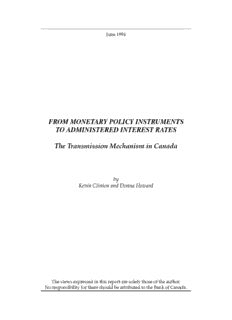
from monetary policy instruments to administered interest rates PDF
Preview from monetary policy instruments to administered interest rates
June 1994 FROM MONETARY POLICY INSTRUMENTS TO ADMINISTERED INTEREST RATES The Transmission Mechanism in Canada by Kevin Clinton and Donna Howard The views expressed in this report are solely those of the author. No responsibility for them should be attributed to the Bank of Canada. ISSN 0713-7931 ISBN 0-662-22232-6 Printed in Canada on recycled paper CONTENTS ACKNOWLEDGMENTS ......................................................................................v ABSTRACT .........................................................................................................vii RÉSUMÉ ............................................................................................................viii 1 INTRODUCTION............................................................................................1 2 INFLUENCE OF POLICY ON MONEY MARKET RATES .........................3 2.1 Tools of monetary policy........................................................................3 2.1.1 Settlement balance management.................................................3 2.1.2 Open-market operations..............................................................7 2.2 A period of market turbulence: autumn 1992.........................................8 2.3 From money market rates to 5-year bond rates.....................................10 3 PRIME LOAN RATES...................................................................................15 3.1 Banking structure and developments....................................................15 3.2 Marginal cost of funds used for business loans.....................................16 3.3 Spreads between prime and money market rates..................................19 3.3.1 Is there a floor to the prime rate?..............................................20 3.4 Equations for the prime rate..................................................................22 3.5 Unusually low prime rate spreads, 1991–92.........................................26 4 SAVINGS DEPOSIT RATES ........................................................................29 5 MORTGAGE AND LONG-TERM DEPOSIT RATES .................................33 5.1 Market structure and developments......................................................33 5.2 Links between market yields and mortgage and GIC rates...................38 5.3 Equations for mortgage and long-term deposit rates............................39 6 CONCLUSIONS.............................................................................................45 REFERENCES .....................................................................................................47 v ACKNOWLEDGMENTS The authors would like to thank Rohit Gupta for capable assistance with the econometrics, as well as Pascal Farahmand and Mark Farber for help on several points. Charles Freedman, John Kuszczak, David Longworth and Steve Harris provided comments that have materially improved the paper. vii ABSTRACT The authors investigate interest-rate aspects of the transmission mecha- nism of monetary policy instruments in Canada, focussing on the stability of the relationships between some key interest rates and the instruments of monetary policy. To determine what shifts may have occurred in recent years, they describe movements in rate differentials, apply cointegration tests and estimate error-correction models. Some changes in the short-run behaviour of money market yields, prime lending rates and mortgage rates between the 1980s and the 1990s are apparent. However, the basic links of the interest-rate channel of transmission – from policy instruments through short-term rates to short-term bond rates and administered rates – seem essentially stable. viii RÉSUMÉ Dans la présente étude, les auteurs examinent le profil des taux d'intérêt en tant que courroie de transmission de la politique monétaire au Canada. Ils étudient en particulier la stabilité des relations entre certains taux d'intérêt directeurs et les instruments de la politique monétaire. Afin de déterminer si ces relations ont subi des changements ces dernières années, ils ana- lysent les fluctuations des écarts de taux et procèdent à des tests de cointé- gration et à des estimations de modèles de correction d'erreurs. Les résultats obtenus permettent de constater certaines modifications dans le comportement à court terme des taux de rendement du marché monétaire, des taux de base des prêts bancaires et des taux hypothécaires au cours des années 80 et 90. Toutefois, les liens fondamentaux des taux d'intérêt comme courroie de transmission de la politique monétaire paraissent essentiellement stables. Ces liens qui proviennent des instruments de poli- tique monétaire se répercutent sur les taux des obligations à court terme et sur les taux administrés par le truchement des taux d'intérêt à court terme. 1 1 INTRODUCTION In this paper we discuss the influence of Bank of Canada instruments on interest rates, focussing especially on the posted interest rates on loans and deposits at financial institutions. These are administered rates, in the sense that each institution itself decides what rate to post and does not change the rate with high frequency. We start by outlining the new system of policy implementation designed for zero reserve requirements and describe how it worked during a trying period in late 1992. The primary issue for the purposes of this report is whether the new framework has delivered a satisfactory degree of influence over money market interest rates. We go on to discuss the stabil- ity of the links from money market rates to short-term bond yields, which impinge directly on certain administered rates. We outline the relevant fea- tures of the markets for several key administered-rate instruments: busi- ness loans, savings deposits, and residential mortgages and retail long- term deposits. Data on yield differentials are used to give a general picture of some of the key facts. Cointegration tests and error-correction models (ECMs) are used to shed light on the dynamics of rate setting and to look at how these may have changed since 1990. This report contains little on the exchange rate, except to discuss how it has affected the setting of short-term interest rates. However, the exchange rate is a very important component of short-run monetary condi- tions in Canada. A change in monetary conditions initiated by the central bank may be reflected in a change in the external value of the currency as well as in the level of short-term interest rates. One difficulty in consider- ing the exchange rate in this context is that its response to a policy action tends to be less predictable than that of short-term interest rates, and more dependent on the state of expectations.
Description: